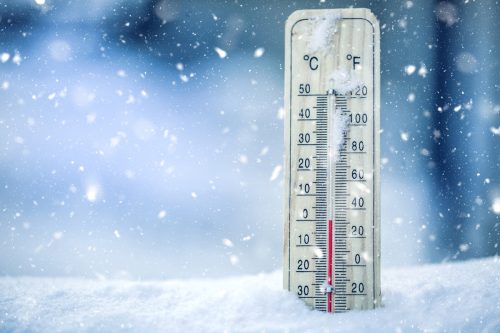“Remarkable” Polar Vortex Disruptions Could Send Temps Plummeting Again—Here’s When

Despite what a groundhog might have led you to believe, the early spring we’ve been anticipating might look a little more complicated than expected. Even with warmer weather very much on the horizon, some experts are now warning that the polar vortex could once again shake things up before winter officially ends. Read on to find out more about the “remarkable” polar vortex disruptions that could send temps plummeting, and when you’ll have to bundle up once more.
RELATED: This Week’s Winter Storm Could Bring Even More Snow to These Regions.
Polar vortex disruptions are possible in the next few weeks.

Hoping for warm weather next month? You may be out of luck. New weather models indicate that disruptions of the polar vortex could put some of the U.S. back into wintry weather around mid-March, The Washington Post reported.
These models show that the vortex will abruptly weaken or collapse in about two weeks—a disruption that Judah Cohen, long-range forecaster at Verisk Atmospheric and Environmental Research, told the newspaper will be “fairly large.”
This is something many experts weren’t anticipating, as we already saw one polar vortex disruption back in January.
“What is remarkable is we have a second disruption to the stratospheric vortex happening right now,” Andrea Lang, PhD, a professor of atmospheric sciences at the University of Wisconsin at Madison, told WaPo. “Two major disruptions to the polar vortex in one season is not common. It has happened before, but it is not something that you expect to happen in any given winter season.”
RELATED: New Spring Forecast Shows Which U.S. Regions Will Be Warmer and Wetter This Year.
This could send temperatures plummeting in the East.

The disruptions will potentially displace cold air due to a change in Arctic Oscillation (AO), which is a natural climate pattern that affects how the polar vortex is configured, according to the National Snow and Ice Data Center (NSIDC). When the AO is positive, the polar vortex’s cold air tends to remain toward the north. The negative phase of AO pushes it farther south, however.
Long-range weather models currently suggest that the AO will turn negative sometime around March 7, which is likely to set off one to two weeks of cold, stormy weather for those east of the Rocky Mountains during the middle of next month, WaPo reported.
“That would put a return of colder weather [for the Eastern U.S.] in mid-March,” Cohen confirmed.
RELATED: “Extended Winter” May Keep Things Cold in These Regions, Meteorologists Predict.
But it may get warmer first.

If you live in the eastern part of the U.S., you might get hit with warmer weather before the polar vortex disruptions. During the last week of February, an area of the country stretching from Dallas north to Minneapolis and east to Philadelphia is likely to see temperatures that are more common in May or June, CNN reported.
According to the news outlet, the warmth is expected to reach the East Coast by Feb. 28—bringing highs in the 60s for cities like Philadelphia and New York. But milder-than-average temperatures in the eastern U.S. during the lead-up to the polar vortex disruption are expected and “consistent with the weather model forecasts,” Cohen told WaPo.
“A major sudden stratospheric warming is likely to occur during the first week of March,” Simon Lee, a research scientist at Columbia University, explained to the newspaper. “These events do, on average, bring about a negative Arctic Oscillation pattern at the surface.”
This could lead to even colder weather than already expected.

Don’t let the warmth fool you. Cohen reiterated that the Eastern U.S. is still expected to turn colder after the stratospheric warming—about two weeks after.
The warmer-than-average temperatures at the beginning of the month may even be more deceptive if the polar vortex becomes stretched out during the sudden stratospheric warming. If that occurs, the stretch vortex could react like a rubber band and snap, sending temperatures plummeting farther and sooner than expected, Cohen explained.
“That can result in a quicker return of colder air to the Eastern U.S. and more intense cold,” the forecaster said. “This is something that I am watching but for now I don’t see any signs of it in the weather models. If we do get a stretched polar vortex that piggybacks on the [sudden stratospheric warming], then colder weather can return to the Eastern U.S. sometime during the first two weeks of March.”
- Source: NSIDC: What is the polar vortex?